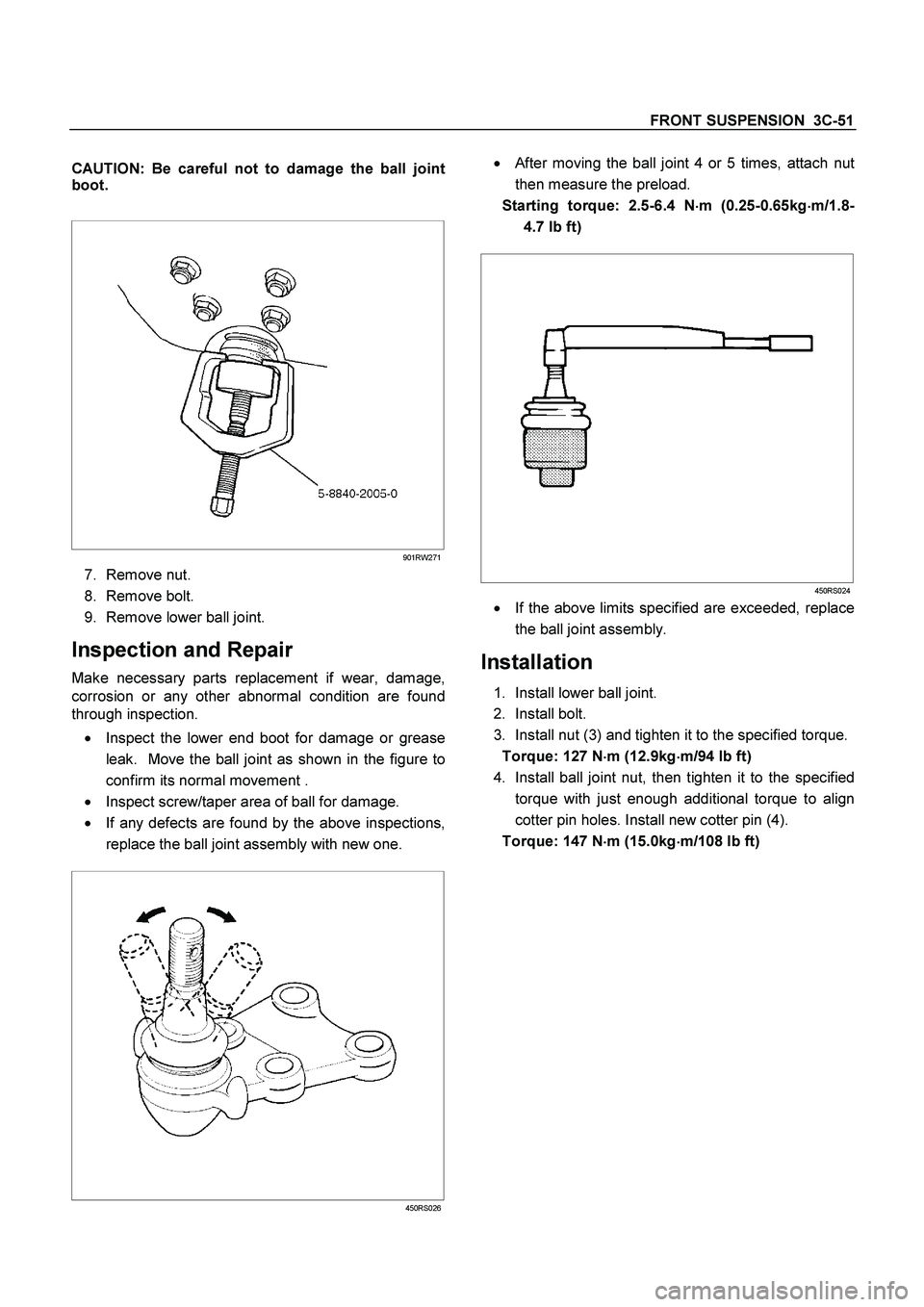Page 3542 of 4264
3C-50 FRONT SUSPENSION
Lower Ball Joint
Lower Ball Joint and Associated Parts
RTW340LF001601
Legend
(1)
Bolt
(2)
Lower Ball Joint
(3) Nut
(4)
Nut and Cotter Pin
Removal
1. Raise the vehicle and support the frame with
suitable safety stands.
2. Remove wheel and tire assembly. Refer to Wheel
in this section.
3. Remove the tie-rod end from the knuckle. Refer to
Power Steering Unit in Steering section.
4. Remove the retaining ring from the front axle
driving shaft to release the shaft from hub. Refer to
Front Hub and Disc in Driveline/Axle section.
5. Support lower control arm with a jack.
6. Remove lower ball joint nut and cotter pin, then
use remover 5-8840-2005-0 to remove the lowe
r
ball joint from the knuckle.
Page 3543 of 4264

FRONT SUSPENSION 3C-51
CAUTION: Be careful not to damage the ball joint
boot.
901RW271
7. Remove nut.
8. Remove bolt.
9. Remove lower ball joint.
Inspection and Repair
Make necessary parts replacement if wear, damage,
corrosion or any other abnormal condition are found
through inspection.
�
Inspect the lower end boot for damage or grease
leak. Move the ball joint as shown in the figure to
confirm its normal movement .
�
Inspect screw/taper area of ball for damage.
� If any defects are found by the above inspections,
replace the ball joint assembly with new one.
450RS026
� After moving the ball joint 4 or 5 times, attach nut
then measure the preload.
Starting torque: 2.5-6.4 N�
�� �m (0.25-0.65kg�
�� �m/1.8-
4.7 lb ft)
450RS024
�
If the above limits specified are exceeded, replace
the ball joint assembly.
Installation
1. Install lower ball joint.
2. Install bolt.
3. Install nut (3) and tighten it to the specified torque.
Torque: 127 N�
�� �m (12.9kg�
�� �m/94 lb ft)
4. Install ball joint nut, then tighten it to the specified
torque with just enough additional torque to align
cotter pin holes. Install new cotter pin (4).
Torque: 147 N�
�� �m (15.0kg�
�� �m/108 lb ft)
Page 3544 of 4264
3C-52 FRONT SUSPENSION
Bump Rubber
Bump Rubber and Associated Parts
RTW340MF001001
Legend
(1)
Bolt
(2)
Bump Rubber
Removal
1. Raise the vehicle and support the frame with
suitable safety stands.
2. Remove bolt.
3. Remove bump rubber.
Inspection and Repair
Make necessary correction or parts replacement if
wear, damage, corrosion or any other abnormal
condition are found through inspection.
Check the following parts :
� Bump Rubber
Installation
1. Install bump rubber.
NOTE: Arrow points to be vehicle outer side of afte
r
assembly to vehicle.
2. Install bolt (1), then tighten it to the specified
torque.
Torque: 42 N�
�� �m (4.3kg�
�� �m/31 lb ft)
Page 3545 of 4264
FRONT SUSPENSION 3C-53
Special Tools (4�
�� �
2 High Ride Suspension, 4�
�� �
2)
ILLUSTRATION PART NO.
PART NAME
ILLUSTRATION
PART NO.
PART NAME
5-8840-2000-0
(J-23907)
Remover; Needle bearing
5-8840-0019-0
Sliding hammer 5-8840-2123-0
(J-36833)
Remover and Installer kit;
Lower arm front bushing
5-8840-2128-0
(J-36838)
Installer; Needle bearing 5-8840-2124-0
(J-36834)
Remover and Installer kit;
Lower arm rear bushing
5-8840-0007-0
(J-8092)
Grip 5-8840-2121-0
(J-36831)
Ball joint remover
5-8840-2127-0
(J-36837)
Installer; Oil seal 5-8840-2005-0
(J-29107)
Tie-rod end remover
5-8840-2307-0
(J-39376)
Installer; Upper arm
bushing
5-8840-0256-0
(J-29775)
Remover and Installer
Upper arm bushing
Page 3546 of 4264

3C-54 FRONT SUSPENSION
TROUBLESHOOTING
1. VIBRATION, SHOCK, AND SHIMMY OF STEERING WHEEL
Checkpoint Trouble Cause Countermeasure
Check front axle
Check wheel alignment
Check suspension ball joint
Check shock absorber or
attaching nut and bolt
Replace
Adjust
Replace
Replace or retighten
Check steering unit and
linkage
Faulty
Worn
Malfunction or loose
Check upper and lower link
bushings
Replace
Adjust
Worn
Incorrect
OK OK OK
NG NG NG NG NG NG
OK OK
Check vehicle trim height
�
Improperly adjusted or worn front
wheel bearing.
�
Worn or incorrectl
y adjusted wheel
bearing.
Replace; refer to Section 4C "Front
Wheel Drive"
�
Insufficientl
y tightened steeringgear housing.
�
Wear of steering linkage.
�
Excessive backlash due to
improper ad
justment of the steeringgear box.
� Worn column bearing weakened
column bearing spring, or loose
clamp.
Replace; refer to Section 3B
"Steering"
�
Improper tire pressure.
� Imbalance and deformation of frond
wheel.
�
Unevenl
y worn tire or insufficient
tightening of wheel nuts.
Replace; refer to Section 3E "Wheel
and Tires"
Page 3547 of 4264
FRONT SUSPENSION 3C-55
2. VEHICLE PULLS TO RIGHT OR LEFT
Checkpoint Trouble Cause Countermeasure
Steering linkage, and upper
and lower link
Rubber bushing for upper and
lower link
Wheel alignment
Vehicle trim height
Replace
Replace
Adjust
Adjust
Deformed
Worn
Incorrect
Incorrect
Brake adjustment (binding)
Adjust
Replace
Incorrect
Collapsed or break (4�
2
Except high ride suspension)
Collapsed or twisted (4�
4, 4�
2
High ride suspension)
Continued on the next pageOK OK OK OK
NG NG NG NG NG NG
OK OK Coil spring (4�2 Except high
ride suspension)
Torsion bar (4�
4, 4�
2 High
ride suspension)
Front wheel bearing
Adjust or replace
Incorrect adjustment or
abrasion
NG
Page 3548 of 4264
3C-56 FRONT SUSPENSION
Checkpoint Trouble Cause Countermeasure
Tire tread (right and left)
Replace (tire)
Difference in wear and tear
Adjust or tighten
Improper or instufficient
tightening
NG NG
OK
Tire pressure or wheel nuts
Continued from the previous page
Page 3549 of 4264
FRONT SUSPENSION 3C-57
3. INSTABILITY OF VEHICLE
Checkpoint Trouble Cause Countermeasure
Tire pressure
Wheel alignment
Rubber bushings for upper
and lower links. (4 � 2 Except
high ride suspension)
Adjust
Adjust
Replace
Incorrect
Incorrect
Worn
Steering linkage and upper
and lower links
Replace
Adjust
Worn or deformed
Incorrect
OK OK OK
NG NG NG NG NG
OK OK
Vehicle trim height
Road wheel
Adjust
Deformed or unbalanced
NG